International Tourism Statistics By Market, Revenue, Countries And Facts (2025)
Updated · Aug 29, 2025

Table of Contents
- Introduction
- Editor Choice
- Global Tourism Market Size Statistics
- By Segments
- Global Leisure Tourism Spending Statistics
- Global Travel and Tourism to Gross Domestic Product (GDP) Statistics
- International User Statistics for Tourism and Luxury Travel
- Number of International Tourist Arrivals Statistics
- By Region (from 2020 to 2024)
- International Tourism Statistics by Distribution of Sales Channels
- Tourism Earnings Statistics by Popular Global Destinations
- By Internal Tourism Revenue Shares
- International Travel and Tourism Website Statistics by Visit Share
- International Tourism Statistics by Cheapest and Expensive Countries
- Global Travel and Tourism Employment Statistics
- Carbon Footprint of International Tourism Transport Statistics by Type
- Conclusion
Introduction
International Tourism Statistics: International tourism means people travelling to another country and staying there for a short time, without planning to live or work there permanently. It can be for holidays, business trips, or other reasons. This type of travel is an important part of the world’s economy and culture.
In recent years, better transport, faster internet, and easier visa rules have made it simpler for people to travel abroad. More and more travelers are visiting places outside their own countries, bringing new energy to local economies. This movement of people has helped towns and cities grow, while giving communities a chance to share their culture, history, scenery, and traditions with the world.
As countries adapt to shifting travel patterns, sustainability, and changing consumer expectations, international tourism continues to redefine how societies interact, trade, and share experiences.
Editor Choice
- news.market.us stated that the global tourism market size has reached around USD 2 trillion in 2024.
- The total revenue projected by the international travel and tourism market has reached USD 915.99 billion in the same period.
- By the end of 2025, the online and offline shares of the market will rise to 71.13% and 28.87%, respectively.
- Based on the segmental analysis of 2024, hotels accounted for USD 426.42 billion, followed by package holidays (USD 300.88 billion), vacation rentals (USD 100.23 billion), camping (USD 46.16 billion), and Cruises (USD 42.3 billion).
- The total global leisure tourism spending in 2025 is estimated at USD 7,235 billion.
- By the end of 2025, the World Travel & Tourism Council (WTTC) expects the industry to generate around USD 11.7 trillion, making up roughly 10.3% of the world’s total GDP.
- The travel and tourism sector’s share will grow further, reaching around 11.4% of global GDP by 2034.
- The global number of users in the travel and tourism sector is estimated to be approximately 2,123.31 million in 2025.
- A report published by Freetour.com shows that international tourist arrivals continued to grow by 3% to 5% in 2025, which would mean international arrivals reaching approximately 1.5 to 1.54 billion.
- As of 2024, the total number of international tourist arrivals remains highest in the European region, with around 755.7 million visitors, as mentioned in textquery.app.
- As of 2024, in the United States, international tourism made up 33% of all tourism income, the highest share worldwide.
- The Statista report of 2024 states that the global distribution of visits to international travel and tourism websites was led by Booking.com, which captured a dominant 7.07% share of total visits.
- com in 2025 estimates that Barbados tops the list of costly places to visit, with an average daily expense of USD 330, while Laos is the most affordable travel destination, where visitors can get by on about USD 15.
- The World Travel & Tourism Council report shows that in 2024, travel and tourism globally supported approximately 357 million jobs.
- According to UN Tourism reports, emissions are expected to rise from 458 million tonnes of CO2 in 2016 to 665 million tonnes by 2030 (an increase of approximately 45%).
Global Tourism Market Size Statistics
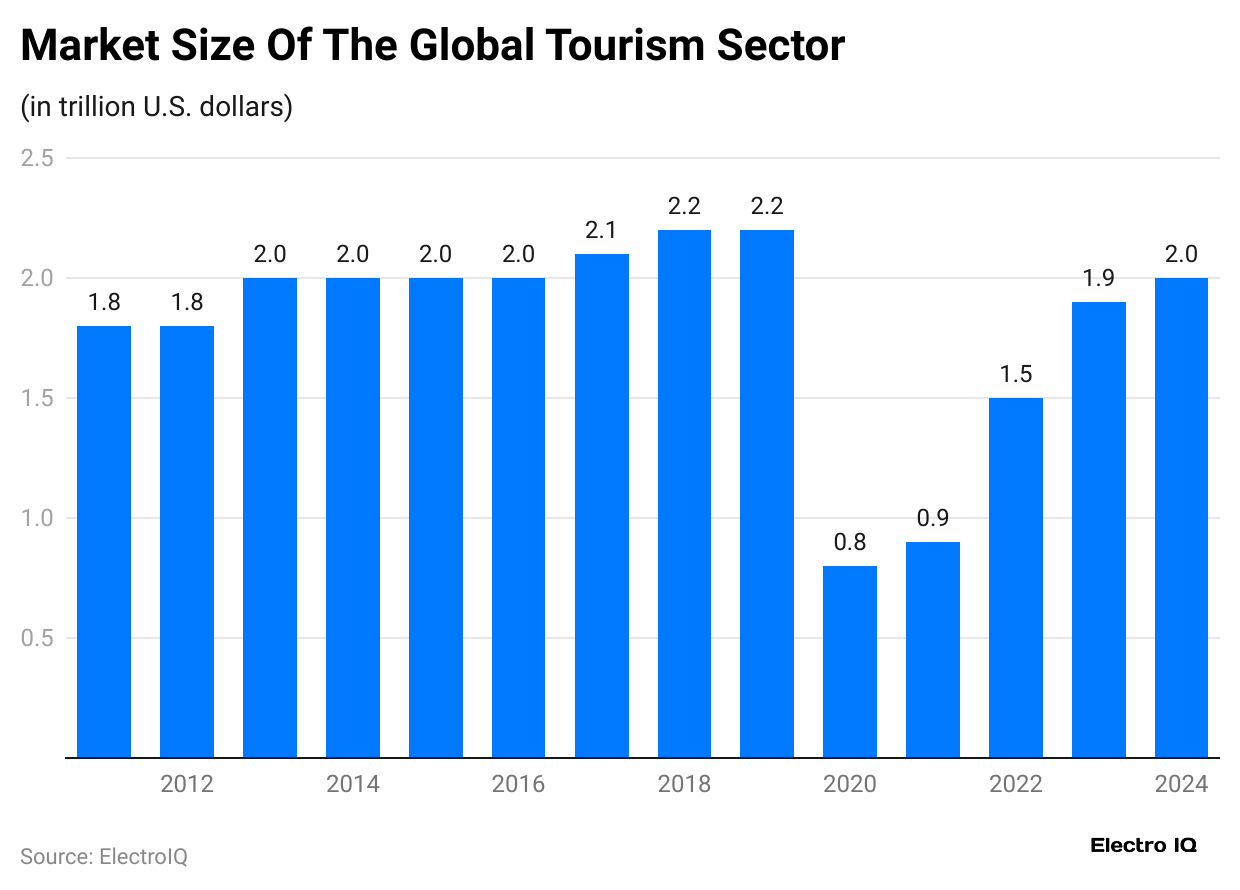
- Between 2011 and 2012, the global tourism market stayed steady at about USD 1.8 trillion.
- From 2013 to 2016, it grew each year, averaging around USD 2 trillion, then rose further to USD 2.1 trillion in 2017 and USD 2.2 trillion in both 2018 and 2019.
- In 2020, the market shrank to just USD 0.8 trillion, followed by 2021 (USD 0.9 trillion), 2022 (USD 1.5 trillion), and 2023 (USD 1.9 trillion).
- Forecasts suggest that in 2024, the sector will fully recover, returning to about USD 2 trillion.
By Segments
- As mentioned in news.market.us, the total revenue projected by the international travel and tourism market has reached up to USD 915.99 billion in 2024.
- Based on the segmental analysis, hotels accounted for USD 426.42 billion, followed by package holidays (USD 300.88 billion), vacation rentals (USD 100.23 billion), camping (USD 46.16 billion), and Cruises (USD 42.3 billion).
Furthermore, other segmental analyses of the international tourism market in the coming years are stated in the following:
| Year | Global revenue | Hotel | Package holidays | Vacation rentals | Camping | Cruises |
| (USD billion) | ||||||
|
2025 |
955.83 | 442.97 | 313.9 | 105.71 | 48.86 | 44.39 |
| 2026 | 993.37 | 459.19 | 325.33 | 110.59 | 51.7 |
46.56 |
|
2027 |
1,032.06 | 475.97 | 337.2 | 115.43 | 54.68 | 48.78 |
| 2028 | 1,071.89 | 493.22 | 349.54 | 120.33 | 57.73 |
51.07 |
|
2029 |
1,114.36 | 511.86 | 362.62 | 125.58 | 60.81 |
53.49 |
Global Leisure Tourism Spending Statistics
- In 2020, the total global leisure tourism spending was USD 5,130 billion and grew to USD 5,541 billion in 2021, to USD 5,932 billion in 2022, and reached USD 6,340 billion in 2023, according to news.market.us.
- It is expected to keep rising, hitting USD 6,773 billion in 2024 and USD 7,235 billion in 2025.
- Forecasts suggest it could climb to USD 7,723 billion in 2026, USD 8,227 billion in 2027, USD 8,761 billion in 2028, and reach about USD 9,332 billion by 2029.
Global Travel and Tourism to Gross Domestic Product (GDP) Statistics
- According to the World Travel & Tourism Council’s report of 2019, travel and tourism added about USD 9.2 trillion to the world economy, making up roughly 10.3% of the total global GDP.
- In 2024, travel and tourism added around USD 10.9 to 11.1 trillion to the world economy, making up roughly 10% to 10.3% of global GDP.
- By the end of 2025, it is expected that the industry will generate around USD 11.7 trillion, making up roughly 10.3% of the world’s total GDP.
- By 2035, the sector will add nearly USD16.5 trillion to the world economy, equal to about 11.5% of global GDP.
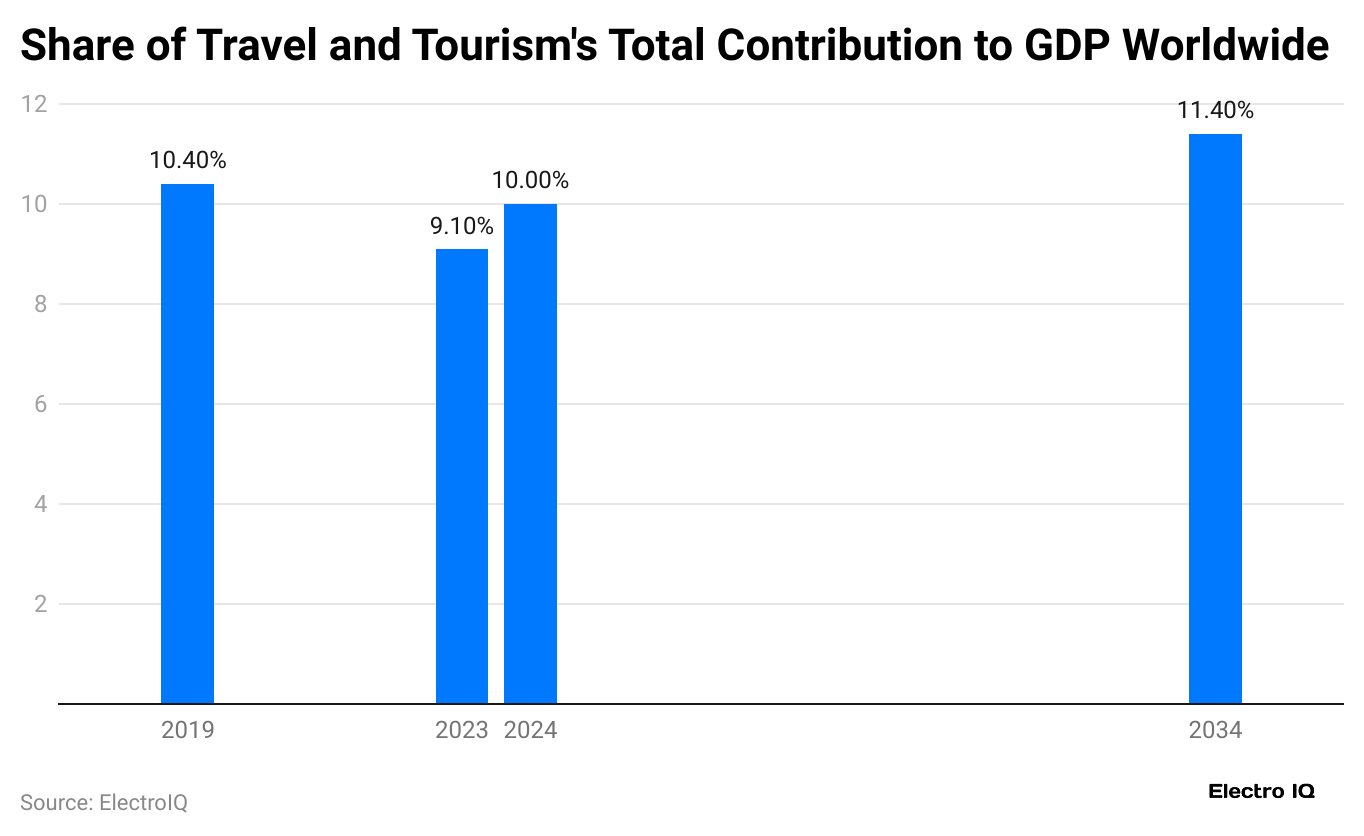
- In 2019, travel and tourism made up 10.4% of the world’s GDP.
- The share dropped to 9.1% in 2023 but is set to recover to 10% in 2024.
- Looking ahead, forecasts suggest the sector’s share will grow further, reaching around 11.4% of global GDP by 2034.
International User Statistics for Tourism and Luxury Travel
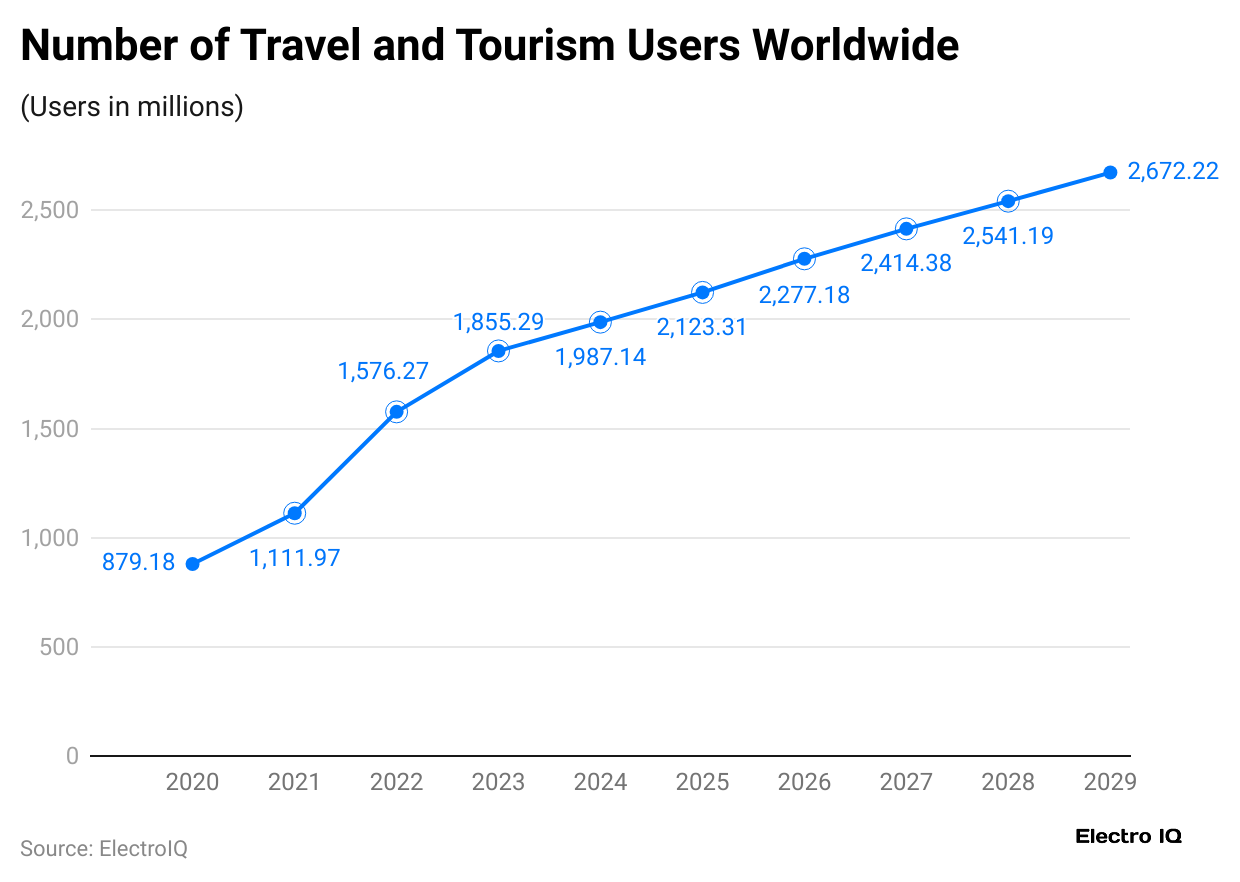
- The global travel and tourism sector has reached 1,987.14 million in 2024 and is estimated to be approximately 2,123.31 million in 2025.
- Furthermore, in the coming years, the total number of users is estimated to reach 2,277.18 million by 2026, followed by 2,414.38 million (2027), 2,541.19 million (2028), and 2,672.22 million (2029).
Number of International Tourist Arrivals Statistics
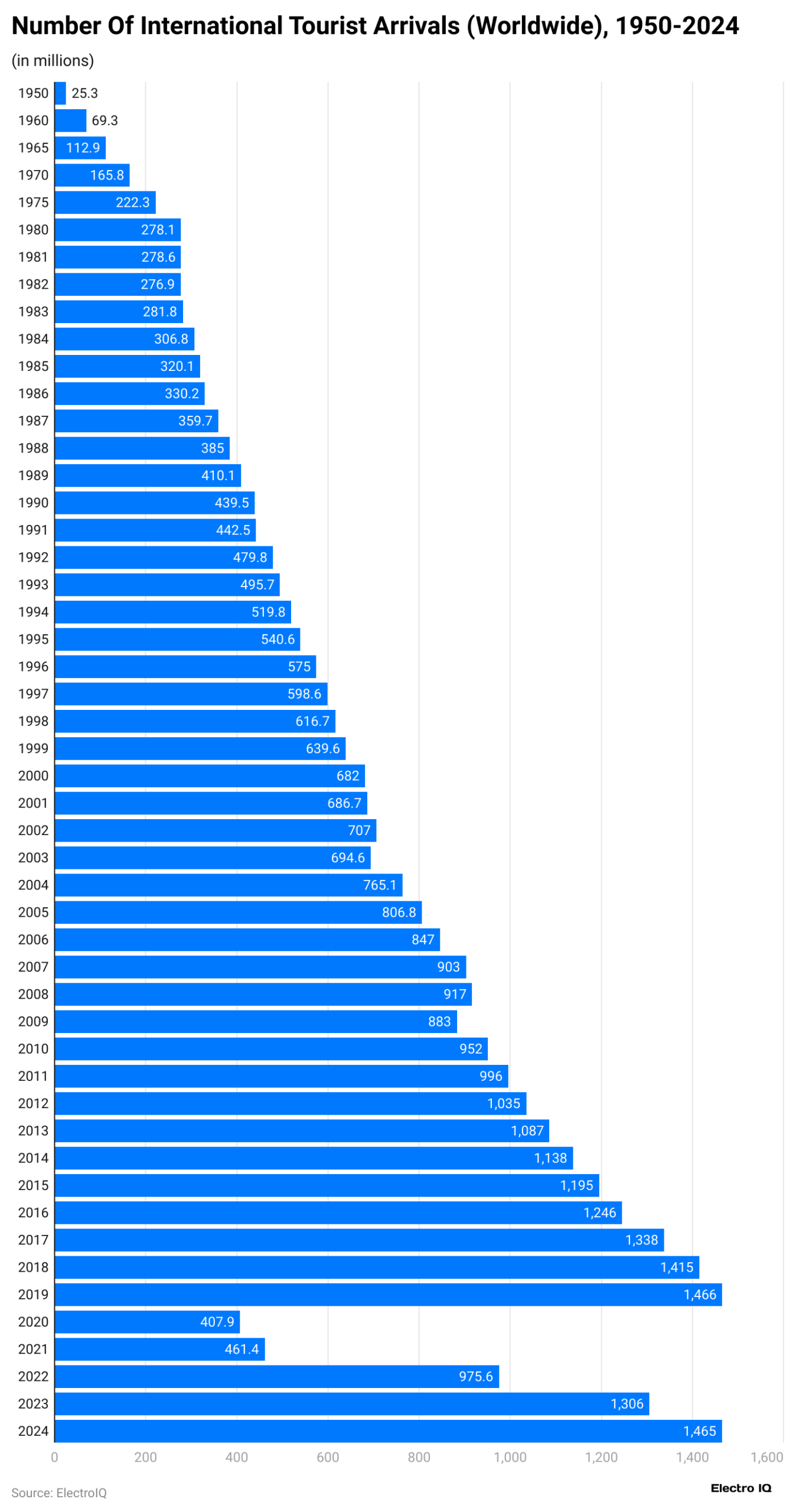
- The number of international tourists grew from around 25.3 million in 1950 to 69.3 million just ten years later.
- In 2024, the total number of travellers around the world reached 1.465 billion.
Furthermore, other tourist arrivals are mentioned in the table below from 1965 to 2023:
| Year | International tourist arrivals (in million) |
| 1965 | 112.9 |
| 1970 | 165.8 |
| 1975 | 222.3 |
| 1980 | 278.1 |
| 1981 | 278.6 |
| 1982 | 276.9 |
| 1983 | 281.8 |
| 1984 | 306.8 |
| 1985 | 320.1 |
| 1986 | 330.2 |
| 1987 | 359.7 |
| 1988 | 385 |
| 1989 | 410.1 |
| 1990 | 439.5 |
| 1991 | 442.5 |
| 1992 | 479.8 |
| 1993 | 495.7 |
| 1994 | 519.8 |
| 1995 | 540.6 |
| 1996 | 575 |
| 1997 | 598.6 |
| 1998 | 616.7 |
| 1999 | 639.6 |
| 2000 | 682 |
| 2001 | 686.7 |
| 2002 | 707 |
| 2003 | 694.6 |
| 2004 | 765.1 |
| 2005 | 806.8 |
| 2006 | 847 |
| 2007 | 903 |
| 2008 | 917 |
| 2009 | 883 |
| 2010 | 952 |
| 2011 | 996 |
| 2012 | 1035 |
| 2013 | 1087 |
| 2014 | 1138 |
| 2015 | 1195 |
| 2016 | 1246 |
| 2017 | 1338 |
| 2018 | 1415 |
| 2019 | 1466 |
| 2020 | 407.9 |
| 2021 | 461.4 |
| 2022 | 975.6 |
| 2023 | 1306 |
- A report published by freetour.com shows that international tourist arrivals continued to grow by 3% to 5% in 2025, which would mean international arrivals reaching approximately 1.5 to 1.54 billion.
By Region (from 2020 to 2024)
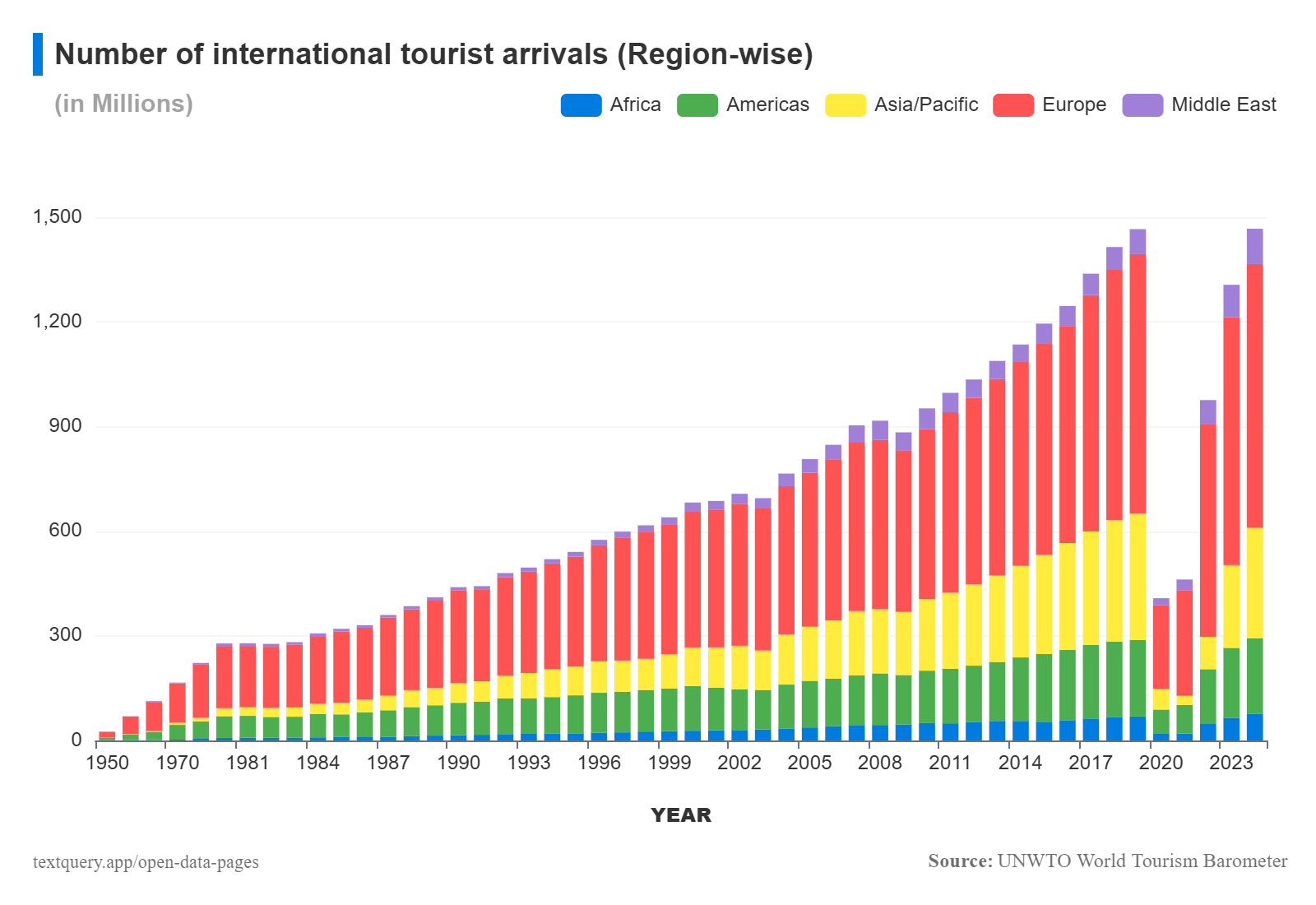
- As of 2024, the total number of international tourist arrivals remains highest in the European region, with around 755.7 million visitors.
- Meanwhile, the Asia Pacific region accounted for 317.5 million visitors in the same period, followed by Americans (216.6 million), the Middle East (101.2 million), and Africa (75.9 million).
| Year | European | Asia Pacific | Americans | Middle East | Africa |
| (in millions) | |||||
| 2023 | 710.2 | 237.4 | 200.2 | 93.4 | 65.1 |
| 2022 | 610.7 | 92.7 | 157.1 | 68 | 47.2 |
| 2021 | 302.8 | 26.5 | 81.7 | 30.5 | 47.2 |
| 2020 | 240.8 | 59 | 69.7 | 19.4 | 18.9 |
International Tourism Statistics by Distribution of Sales Channels
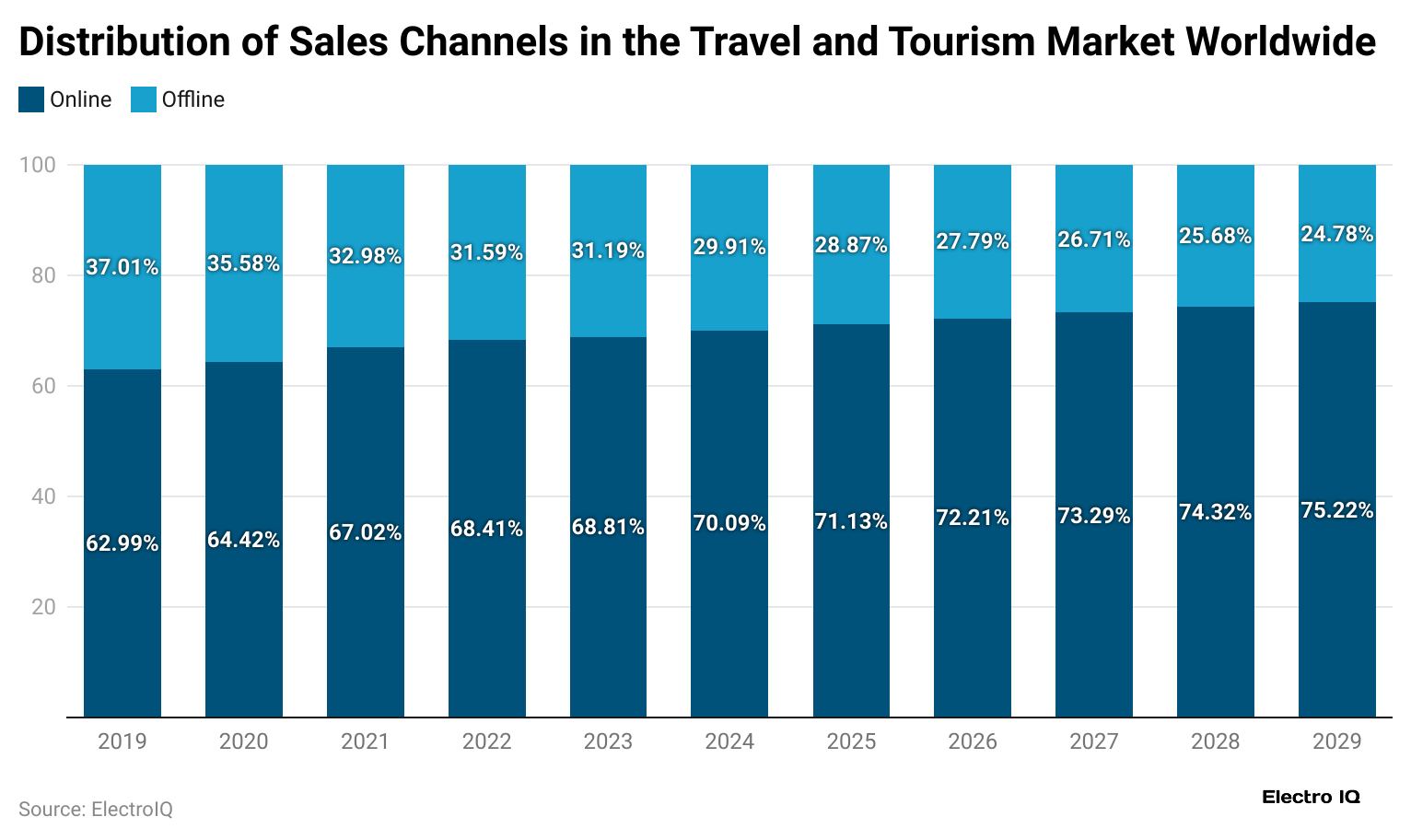
- In 2019, online platforms generated about 63% of total revenue, while offline channels made up roughly 37%.
- The online and offline share rose to 64.42% and 35.58% in 2020, while in 2021 the online and offline sales share accounted for 67.02% and 32.98%, respectively.
- In 2022, online sales represented 68.41% market share, with offline channels declining to 31.59%.
- The online share of the market has reached 68.81% in 2023 and 70.09% in 2024.
- At the same time, offline sales are anticipated to decline to 31.19% and 29.91%, respectively.
- International Tourism Statistics also states that online sales share followed by 2025 (71.13%), 2026 (72.21%), 2027 (73.29%), 2028 (74.32%), and 2029 (75.22%).
- In contrast, the offline sales share is estimated to reach around 2025 (28.87%), 2026 (27.79%), 2027 (26.71%), 2028 (25.68%), and 2029 (24.78%).
Tourism Earnings Statistics by Popular Global Destinations
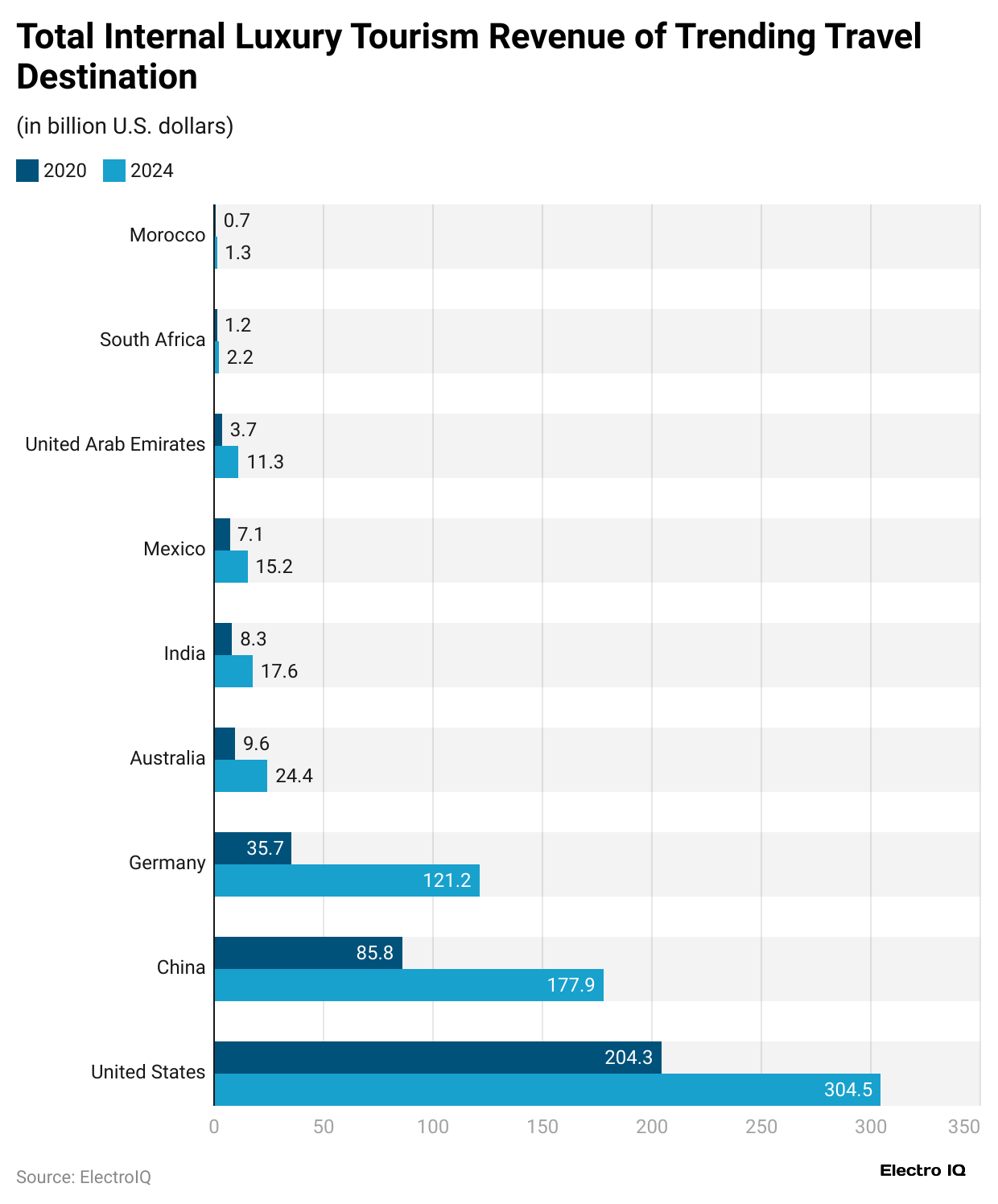
- According to news.market.us, the United States maintains its leadership position with revenue of USD 304.5 billion in 2024.
- In the same duration, China accounted for a revenue of USD 177.9 billion, while Germany secured USD 121.2 billion in revenue and Australia with USD 24.4 billion.
- Meanwhile, total internal luxury tourism revenue in other countries is followed by India (USD 17.6 billion), Mexico (USD 15.2 billion), the United Arab Emirates (USD 11.3 billion), South Africa (USD 2.2 billion), and Morocco (USD 2.2 billion).
- As of 2024, in the United States, international tourism made up 33% of all tourism income, the highest share worldwide.
- Germany followed at 25%, and Australia reached 21%.
- The UAE earned 19% from luxury travel.
- Morocco and South Africa each had 10%, while Mexico and China stood at 9%.
- India’s luxury tourism share was smaller, at 6% of total revenue.
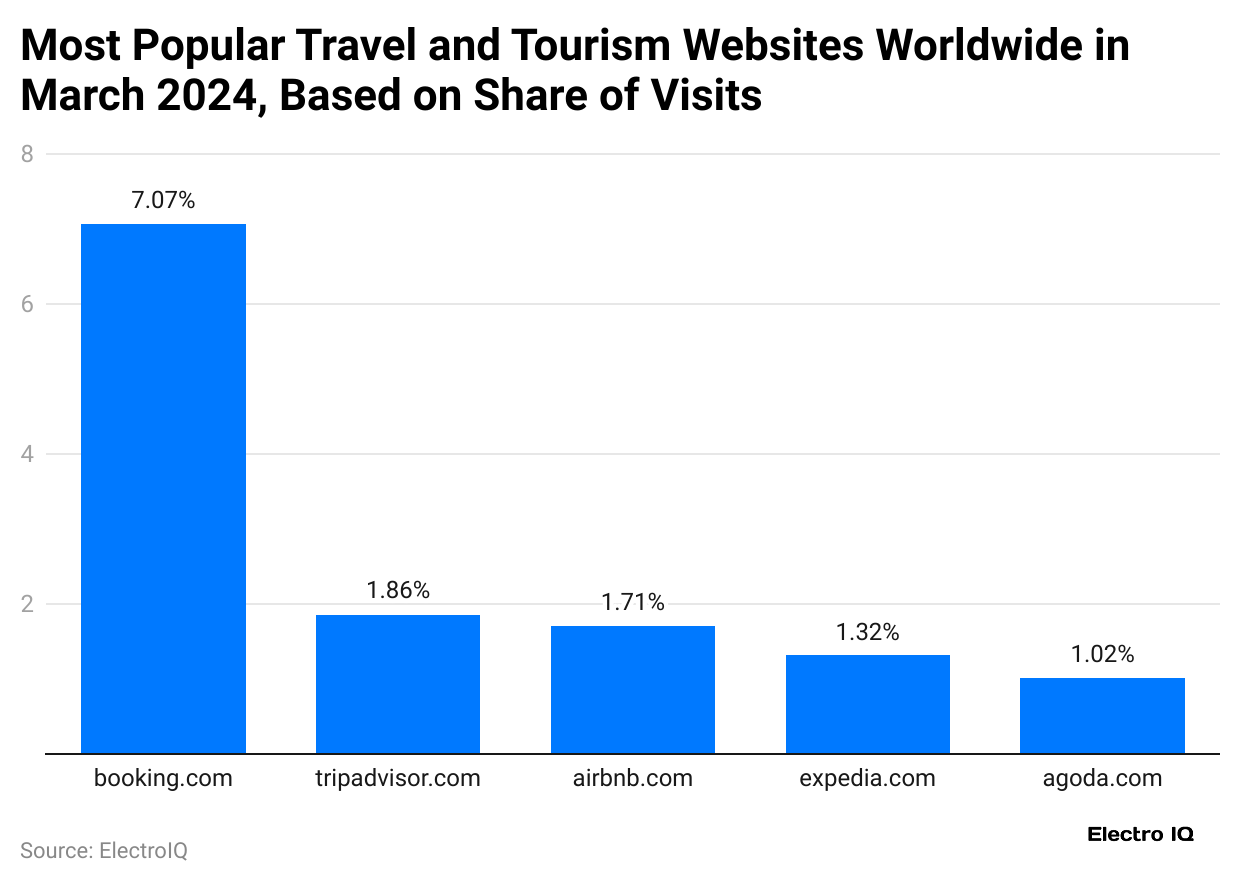
- The above graph, published by Statista in 202,4, states that the global distribution of visits to international travel and tourism websites was led by Booking.com, which captured a dominant 7.07% share of total visits.
- com came next, with 1.86% of the visits.
- com followed closely behind, making up 1.71% of the visits.
- com had 1.32%, and Agoda.com received 1.02% of the total visits.
According to Semrush analysis, the top 10 website visits as of June 2025 are stated below:
| Website | Visits | Pages / Visit | Bounce rate |
| booking.com | 445,682,743 | 6.4 | 41.10% |
| tripadvisor.com | 117,621,054 | 2.62 | 61.67% |
| airbnb.com | 89,037,009 | 7.54 | 46.92% |
| wetter.com | 84,423,968 | 2.36 | 43.6% |
| americanexpress.com | 76,664,027 | 4.78 | 30.9% |
| trip.com | 75,865,141 | 3.51 | 54.93% |
| wetteronline.de | 73,814,630 | 2.28 | 57.29% |
| flightradar24.com | 71,094,928 | 12.95 | 46.1% |
| expedia.com | 69,952,328 | 5.75 |
41.02% |
| agoda.com | 65,609,955 | 5.43 | 45.6% |
International Tourism Statistics by Cheapest and Expensive Countries
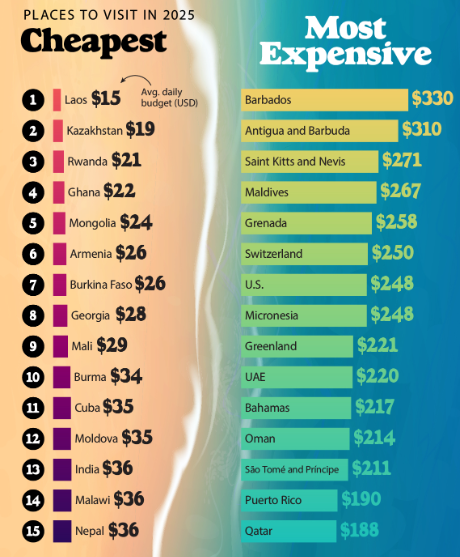
- In 2025, Barbados is the most expensive place to visit, where people spend about USD 330 each day.
- Right behind it is Antigua and Barbuda, with daily costs of nearly USD 310.
- On the opposite end, Laos and Kazakhstan are among the most affordable travel destinations, where visitors can get by on about USD 15 and USD 19 per day, respectively.
Other countries’ estimated budget per day is stated in the table below:
| Cheapest | Expensive | ||
| Country | Daily budget (USD) | Country | Daily budget (USD) |
| Rwanda | 21 | Saint Kitts and Nevis | 271 |
| Ghana | 22 | Maldives | 267 |
| Mongolia | 24 | Grenada | 258 |
| Armenia | 26 | Switzerland | 250 |
| Burkina Faso | 26 | U.S. | 248 |
| Georgia | 28 | Micronesia | 248 |
| Mali | 29 | Greenland | 221 |
| Burma | 34 | UAE | 220 |
| Cuba | 35 | Bahamas | 217 |
| Moldova | 35 | Oman | 214 |
| India | 36 | São Tomé and Príncipe | 211 |
| Malawai | 36 | Puerto Rico | 190 |
| Nepal | 36 | Qatar | 188 |
Global Travel and Tourism Employment Statistics
- The World Travel & Tourism Council report published in 2024 states that the global market accounted for approximately 357 million jobs, representing one in ten jobs worldwide.
- The sector will generate 371 million jobs by the end of 2025, an increase of 14 million from 2024.
- Looking further ahead, WTTC’s projections estimate that the industry will support more than 460 million jobs by 2035, approaching one in eight jobs globally.
Carbon Footprint of International Tourism Transport Statistics by Type
- According to UN Tourism reports, emissions are expected to rise from 458 million tonnes of CO2 in 2016 to 665 million tonnes by 2030 (an increase of approximately 45%).
| Transport Mode | 2016 Emissions (Mt CO2) | 2030 Forecast (Mt CO2) | Change Rate |
| Other Modes | 1,139 | 1,333 | +17% |
| Total Tourism | 1,597 | 1,998 | +25% |
Conclusion
International tourism is very important because it helps people learn about different cultures and brings countries closer together. It creates many jobs and helps local businesses grow, especially in poorer areas. Tourists meet people from different places, which makes their experiences richer and teaches them to respect others. At the same time, it is important to travel in ways that protect nature and keep traditions safe.
By doing this, tourism can continue to help the world while caring for the environment and cultures for the future. As travel continues to evolve with technology and changing preferences, balancing growth with responsibility remains crucial. Ultimately, international tourism holds great potential to unite the world while encouraging respect for the planet and its diverse cultures.
FAQ.
Tourism means going to places away from where you normally live, usually for fun, work, or other reasons. People usually stay there for less than a year and do not earn money while travelling.
In tourism business marketing, four main things are important: the product, the price, the place, and the promotion, which are the elements that help create a successful strategy.
Tourists can be grouped into four types depending on how much they look for new experiences versus familiar ones: the drifter, the explorer, the individual mass tourist, and the organised mass tourist.

Joseph D'Souza founded ElectroIQ in 2010 as a personal project to share his insights and experiences with tech gadgets. Over time, it has grown into a well-regarded tech blog, known for its in-depth technology trends, smartphone reviews and app-related statistics.










